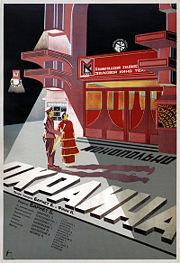From the Chicago Reader (July 30, 2004). — J.R.
Outfoxed: Rupert Murdoch’s War on Journalism
Directed by Robert Greenwald.
DVDs are bringing about rapid and substantial changes in the way we consume movies, and in film culture itself. A case in point is Robert Greenwald’s Outfoxed: Rupert Murdoch’s War on Journalism, which premiered July 13 on DVD and video rather than in theaters. You could have seen it at one of more than 3,000 “house party” viewings organized by MoveOn.org two Sundays ago, or you can just buy it online for $9.95 plus shipping as I did. There must be lots of others like me, because Outfoxed has been Amazon’s top-selling video title for over a week now, and the last time I looked it had 133 customer reviews.
Watching the muckraking examination of the Fox News Channel at home had its advantages: as soon as it was over, I was able to switch directly to Fox to see if it really was as awful as Greenwald’s documentary maintained. (It was.) There are also advantages to keeping a DVD like this on the shelf: you can refer back to certain points in the film for clarification. And facts aren’t all you might want to go back to: if it’s an art film, for instance, you can jump to a favorite passage — a camera movement, a facial expression, a composition, or the delivery of a line of dialogue — the same way you can open a book to revisit some favorite lines of poetry. I’ve even found that there are some passages of film poetry that reveal themselves only when you have this power of effortless access.
Whatever the reasons, the annual profits from DVDs outstripped those of the box office a few years ago. In both businesses most of the money comes from a few blockbuster titles. But there’s something new going on when a supposedly marginal polemic like Outfoxed can catapult itself into the big time, challenging entrenched media powers in the process.
While largely effective, Greenwald’s documentary is not a complete success. Its biggest limitation is its insistence that Fox News is an offense against liberals and the Democratic Party rather than against people in general. It also intermittently taints its analysis with the same kind of primitive insults used by Fox. We are told, for example, that conservative commentator Sean Hannity is “a good-looking, all-American, clean-cut kind of guy,” that Alan Colmes, his liberal foil, “is a little squirrelly looking,” and that the contrast “sends a subtle message.” What is this subtle message? That the not-so-subtle public, including you and me, won’t give political credence to some anchors because of the way they look? Thanks for the vote of confidence, guys.
But it’s probably inevitable that those who gaze long enough into the abyss of Fox News will come away with coarsened sensibilities. The sort of nastiness practiced by Hannity and Bill O’Reilly is contagious. One of the film’s centerpieces is O’Reilly’s arrogant verbal assault on Jeremy Glick, the son of a transit worker who died in the World Trade Center attack. It’s difficult to imagine that the exchange could have gone on much longer without Glick losing his cool as well:
O’Reilly: “Shut up. Shut up.”
Glick: “Oh, please don’t tell me to shut up.”
O’Reilly: “As respect — as respect — in respect for your father, who was a Port Authority worker, a fine American, who got killed unnecessarily by barbarians –”
Glick: “By radical extremists who were trained by this government…”
O’Reilly: “Out of respect for him…”
Glick: “…not the people of America…”
O’Reilly: “…I’m not going to–”
Glick: “…the people of the ruling class, the small minority.”
O’Reilly: “Cut his mike. I’m not going to dress you down anymore, out of respect for your father. We will be back in a moment with more of The Factor.”
Glick: “That means we’re done?”
O’Reilly: “We’re done.”
Before I watched Greenwald’s 77-minute documentary, I had to sit through a trailer for his previous opus, Uncovered: The Whole Truth About the Iraq War (2003). Or so it seemed at the time — I’d momentarily forgotten I had only to hit “menu” on my remote to skip past this imposition, an option unavailable in theaters and less automatic on a VCR. It’s not that I mind trailers, but it’s nice to have some choice in the matter.
I wasn’t interested in this particular trailer because I’d already seen Uncovered at a MoveOn.org-sponsored house party held in my neighborhood last December. About two dozen people were present, the youngest in their 20s, the oldest perhaps in their late 70s. After the screening someone suggested that we try to get Uncovered shown at the Music Box or a multiplex; I countered that I thought that house parties of this kind were a far more appropriate, meaningful, and consequential venue for a film of this kind. (Uncovered, incidentally, is screening at a bar this weekend — a setting that arguably falls somewhere between a house party and a theatrical exhibition. See listings in Section Two for details.)
Given that MoveOn.org — which sponsored Uncovered and Outfoxed and created a ready-made audience for them — is entirely an Internet phenomenon, it seems clear that the notion of “alternative media channels” is fast becoming obsolete. In March the organization sent out an e-mail asking its 2.9 million members to help pay for an anti-Bush television ad featuring Richard Clarke. The ad, which cost $300,000, was aired on Fox and CNN just six days later.
One of the major social potentials of DVDs, it seems to me, is to revive the kind of student-run film societies that proliferated on college campuses in the 60s, albeit with a major difference. Film societies back then depended on 16-millimeter prints, cumbersome projectors that required a modicum of technical savvy, and the availability of auditorium space. A film club that shows DVDs, on the other hand, can exist in someone’s house or apartment, in a storefront or a bar — just about anywhere on the planet.
Much as videos conform to different and incompatible regional formats (NTSC in the U.S. and Japan, PAL in most of Europe, SECAM in France), DVDs are stamped with one of six different regional codes. In the case of video, these barriers are an accidental legacy of varying technical standards adopted by individual nations when television was new. The subdivision of the DVD market happened by design: regional codes were created by the movie industry to protect its copyrights and profits. They’re meant, for example, to prevent DVDs of a given blockbuster released in region one (the U.S.) from reaching region six (China) before the film has completed its theatrical run in the latter market. But the codes are becoming irrelevant, given the increasing availability of multiregional DVD players, which can be had for as little as $60. (Reportedly there are also ways to “hack” some single-region players into multiregional ones, but you’ll have to look elsewhere for advice on how to do that.)
It’s worth investing in a multiregional player if you want to take full advantage of the global movie market. I’m not just talking about foreign films with English subtitles: some of the best American movies are more readily available in other countries than here. Long-distance shopping is easily managed and often less expensive than you might think. (Airmail postage isn’t cheap, even for something as lightweight as a DVD, but when you buy abroad you don’t have to worry about sales tax.)
We’re rapidly approaching a time when anyone living anywhere in the world can theoretically enjoy access to the canon of world cinema once reserved for film students in world capitals like New York or Paris. But availability isn’t everything: people need to know something exists before they can choose to see it. This is why I started writing a column called “Global Discoveries on DVD” for the Canadian quarterly Cinema Scope a year and a half ago. The things I’ve seen since I began monitoring the world market seem to me full of promise. I’ll limit myself to citing a few examples from the past month or so.
In February one of my favorite Russian movies, Boris Barnet’s Okraina (1933), played at Facets Cinematheque. Enduring neglect of this masterpiece moved me to bellyache in these pages that “most mainstream critics and studios tend to be lazy about enlarging the canon, and so they probably don’t have a clue as to what all the important films are, since most of the films ever made aren’t on video or DVD. Of course some of the best films are available at the video store, but the mainstream goes on limiting its definition of classics to films everyone already knows.” This month Kino Video released Okraina (under its English title, Outskirts) along with an earlier Barnet feature, The Girl With the Hatbox, on DVD.
In a chain store I recently picked up The Greatest Jazz Films Ever, a multiregional two-disc set released last year in Spain, which includes the best footage of Charlie Parker in existence. Shot by Life photographer Gjon Mili for an uncompleted follow-up to his Oscar-winning 1944 short Jammin’ the Blues, the sequence captures a relaxed, charismatic Parker miming to a prerecorded track with Coleman Hawkins, Hank Jones, Ray Brown, and Buddy Rich. I first saw this footage six years ago on a rare Japanese video release called Improvisation. When I included the sequence on a list of my 1,000 favorite films I composed for my latest collection of essays, Essential Cinema: On the Necessity of Film Canons, published in April by Johns Hopkins University Press, I wasn’t expecting to see it again anytime soon, much less find it cheap at a local mass retailer. Ironically, the liner notes identify other selections as new to DVD, but not this, the rarest of them all. To all appearances the compilers didn’t even realize what they had — a situation, alas, that’s all too typical.
Many masterpieces of short film have been almost inaccessible for decades, even in their countries of origin. Into this category fall Jean-Pierre Melville’s 24 Hours in the Life of a Clown, Maurice Pialat’s Love Exists, Alain Resnais’ The Song of Styrene (shot in color and ‘Scope and easily the most beautiful “industrial” ever made), Jean-Luc Godard’s Charlotte and Her Jules, and Jacques Rivette’s Fool’s Mate. But a DVD made from beautiful new prints of these five films and three others has just been issued in Korea under a misleading title, Their First Films. I obtained a copy of this gem from a U.S. distributor specializing in schlock horror.
Other rarities I’ve recently found include Chekhov’s Motifs (aka Chekhovian Motifs), one of the craziest features by the Russian eccentric Kira Muratova (it’s on a Russian label with optional English subtitles and available in the U.S.); a fascinating collection of animated World War II propaganda from Disney, some of it unavailable since that time; a splendid French letterboxed copy of Anthony Mann’s Man of the West; Charles Burnett’s To Sleep With Anger and two Kenji Mizoguchi films (released on the British labels BFI and Artificial Eye, respectively); and Louis Feuillade’s stunning 1916 French serial Judex on an American label. (Unfortunately my favorite Feuillade serial, Tih Minh, has yet to find its way to DVD, although his Les vampires and Fantomas have both come out.)
All of this stuff is available to anyone with access to the Internet, which is as much a part of this adventure as DVD technology itself. Film buffs around the world, many of them still in their 20s, are swapping information and educating one another about this unprecedented bounty via blogs and chat groups. All this is amplifying and intensifying grassroots, word-of-mouth communication in a way that threatens to forever alter the power bases that influence cultural matters. Because you no longer have to live in Paris, New York, or Chicago in order to find out who Feuillade was or why he’s so great — and because a “movie” like Outfoxed no longer has to open at a theater or even exist on celluloid in order to have a sizable social impact.
One of the extras on the Outfoxed DVD is a 30-minute “making of” feature, detailing the homey way the documentary was compiled by a team of volunteers in a very short period of time. There are several interviews with individuals assigned to monitor certain shows and cull examples of particular abuses. The ones we meet are all women, many of them suburban retirees. It’s another example of the way that cinema is evolving into a cottage industry, as it becomes easier than ever to make, preserve (at least in digital form), and disseminate. Of course, it’s also becoming more difficult than ever to decide what to watch, as the choices are quickly becoming infinite.







